Naked buckwheat (
Eriogonum nudum)
is a tough plant that is easy to grow and provides important food for pollinators year-round, especially during California’s hottest and driest season. Native bees, honeybees, butterflies and other odd pollinators sip the refreshing nectar during the summer heat. Bees also feed the protein-packed pollen to their young. From fall to spring, birds eat the bountiful and delicious seeds. And if that isn’t enough, naked buckwheat is also an important host plant for caterpillars of the acmon blue butterfly.
This drought-tolerant perennial appears unassuming most of the year, with its 3- to 6-inch low mound of foliage. But come late spring to early summer, it shoots up bare, leafless stems another 1½ to 4 feet above the foliage. These bare stems are its namesake. Yet naked buckwheat is hardly naked; on these bare stems burst forth billows of pretty pom-pom flowers that bees can’t resist. And neither can I.
Naked buckwheat has the widest distribution of the California buckwheats, growing in nearly all of California and parts of Nevada, Oregon and Washington.
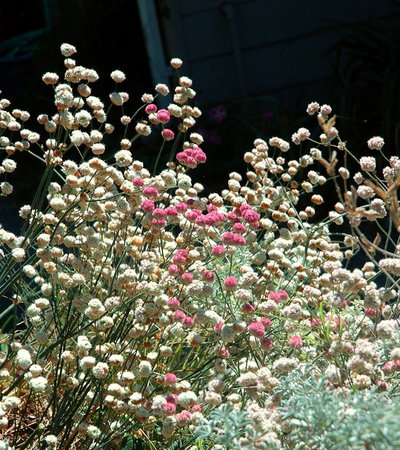
Pete Veilleux, East Bay Wilds
Botanical name: Eriogonum nudumCommon name: Naked buckwheat
Origin: Native throughout California and parts of Nevada, Oregon and Washington
Natural habitat: Many plant communities
Where it will grow: Easily hardy to 30 degrees Fahrenheit, possibly as low as 5 degrees Fahrenheit (USDA zones 6 to 10; find your zone)
Shown: Naked buckwheat with red buckwheat (
Eriogonum grande var.
rubescens)
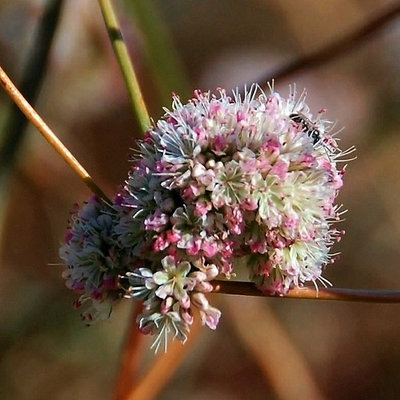
Pete Veilleux, East Bay Wilds
Water requirement: Occasional; drought tolerant
Light requirement: Full sun
Soil: Adaptable; prefers well-drained soil
Mature size: 3- to 6-inch tall basal leaves; flowers 2 to 5 feet tall and 2 feet wide
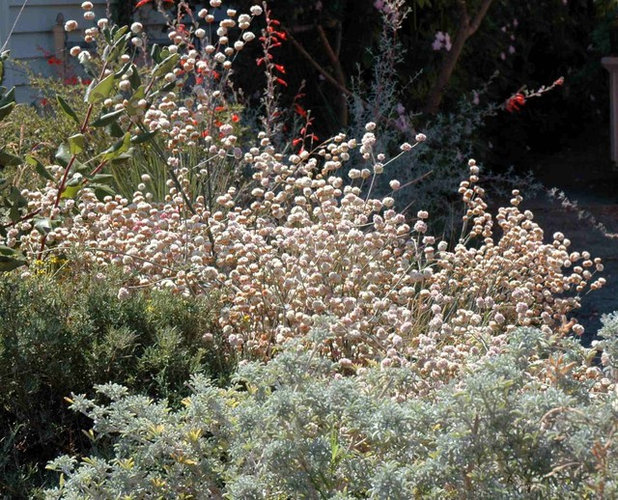
Pete Veilleux, East Bay Wilds
Benefits and tolerances: Attracts butterflies, native bees, honeybees and pollinating insects; tolerates heat, drought, clay and sand; deer resistant
Seasonal interest: Long bloom period, from late spring through summer; attractive seed heads from fall to winter
When to plant: Late fall is ideal; winter works well; spring is acceptable; summer can be challenging to all but the most experienced gardener
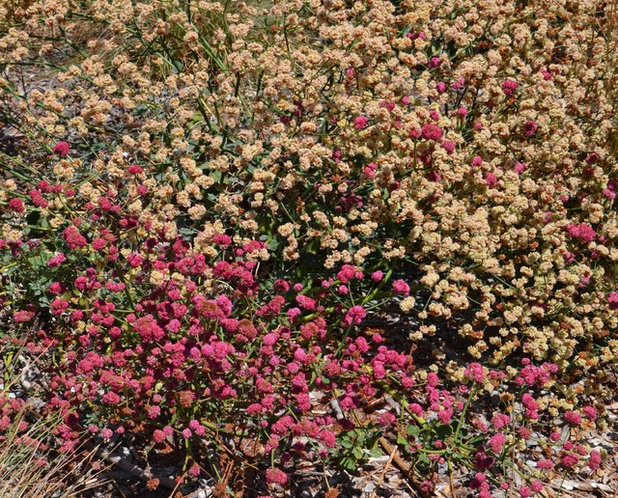
Pete Veilleux, East Bay Wilds
Distinguishing traits. Long bloom period, from late spring through summer; white, pink or yellow pom-poms born on naked stems rise above basal foliage; flowers dry to pleasing seed heads; provides both nectar and pollen to pollinators; provides tasty seeds for birds from fall to spring
Shown: Naked buckwheat (shown with red buckwheat) changing color as it starts its transition from flower to seeds
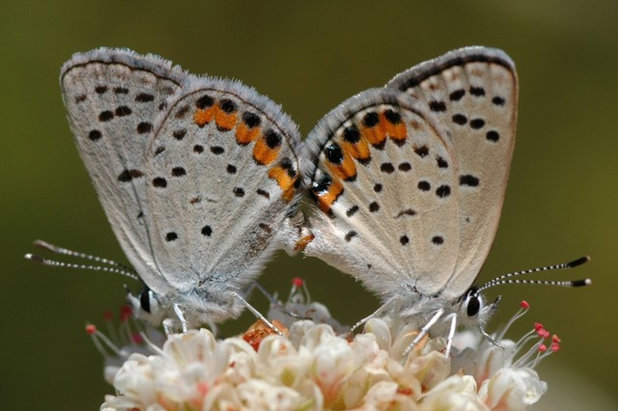
Treebeard
Wildlife value. Buckwheats are important host plants for butterfly caterpillars. Naked buckwheat is host to the caterpillars of the acmon blue butterfly (
Plebejus acmon). The two adults here are mating on California buckwheat (
Eriogonum fasciculatum).
I find it fascinating that acmon blue larvae that feed on buckwheats will have multiple generations a year in the same location, whereas acmon blue larvae that don’t have buckwheats — but instead feed on legumes — will have only one or two generations a year. The larvae feed on the legumes, then have to search for new host plants — hard work for little caterpillars. This also explains why my garden, with 11 buckwheat plants of three species, is home to so many acmon blues, who flit and flutter about the garden throughout the warm months.
Naked buckwheat is an exceptional summer-flowering perennial that provides both nectar and pollen. Native bees and honeybees benefit from the high protein level of the pollen. Adult butterflies — including blues, hairstreaks and metalmarks — along with bees quench their hunger with the rich nectar. Everyone gets a wellspring of food during the hottest months of the year. Then the birds feast on the seeds from fall to spring.
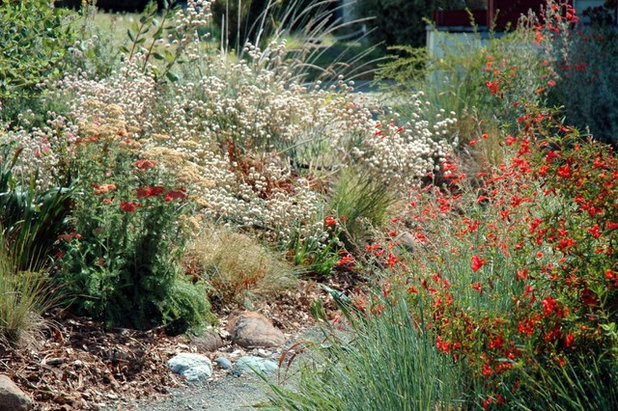
Pete Veilleux, East Bay Wilds
How to use it. Perfect for rock gardens and hot slopes, naked buckwheat can even tolerate hot afternoon summer sun. It is lovely massed for maximum effect. Or plant it with its natural companions, like Catalina hummingbird fuchsia (
Epilobium canum ‘Catalina’, shown here), monkeyflower (
Mimulus and
Diplacus spp) or sagebrush (
Artemisia spp).
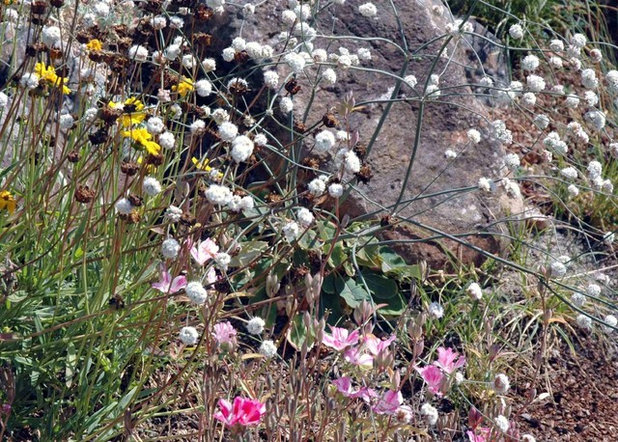
Pete Veilleux, East Bay Wilds
Planting notes. Don’t clean up the garden too early. As with many butterflies, the larvae of the acmon blue butterfly use the litter in, under and near the plant for overwintering. Cleaning up the litter will discard and kill the larvae. No larvae, no butterflies. So savor your fall for loafing around as you look forward to the sweet little blue butterflies in spring.
Using care not to disturb the larvae, you can cut back the flower stalks anytime between fall and early spring. I prefer leaving the seed heads for the birds until winter or spring, yet I keep in mind that naked buckwheat can be a heavy self-sower.

Pete Veilleux, East Bay Wilds
One selected cultivar is ‘Ella Nelson’s Yellow’. Found by Eric Nelson (and named after his grandmother, a lifelong gardener), this naturally occurring cultivar is a reliable sulfur yellow, rather than white or pink.
More:How to Design a Garden for Native Bees
Learn more about gardening with native plants in your area





